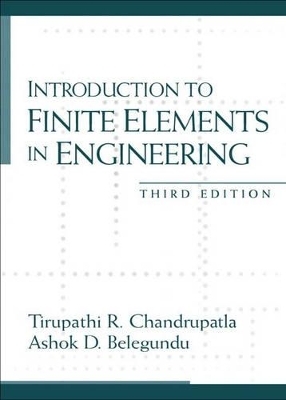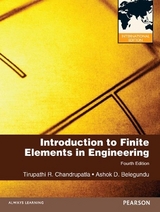
Introduction to Finite Elements in Engineering
Pearson
978-0-13-178453-6 (ISBN)
- Titel erscheint in neuer Auflage
- Artikel merken
For senior undergraduate and first-year graduate students and also as a learning resource to practicing engineers.
This book provides an integrated approach to finite element methodologies. The development of finite element theory is combined with examples and exercises involving engineering applications. The steps used in the development of the theory are implemented in complete, self-contained computer programs. While the strategy and philosophy of the previous editions has been retained, the Third Edition has been updated and improved to include new material on additional topics.
Tirupathi R. Chandrupatla is Professor and Chair of Mechanical Engineering at Rowan University, Glassboro, New Jersey. He received the B.S. degree from the Regional Engineering College, Warangal, which was affiliated with Osmania University, India. He received the M.S. degree in design and manufacturing from the Indian Institute of Technology, Bombay. He started his career as a design engineer with Hindustan Machine Tools, Bangalore. He then taught in the Department of Mechanical Engineering at LLT, Bombay. He pursued his graduate studies in the Department of Aerospace Engineering and Engineering Mechanics at the University of Texas at Austin and received his Ph.D. in 1977. He subsequently taught at the University of Kentucky. Prior to joining Rowan, he was a Professor of Mechanical Engineering and Manufacturing Systems Engineering at GMI Engineering & Management Institute (formerly General Motors Institute), where he taught for 16 years. Dr. Chandrupatla has broad research interests, which include finite element analysis, design, optimization, and manufacturing engineering. He has published widely in these areas and serves as a consultant to industry. Dr. Chandrupatla is a registered Professional Engineer and also a Certified Manufacturing Engineer. He is a member of ASEE, ASME, NSPE, SAE, and SME. Ashok D. Belegundu is a Professor of Mechanical Engineering at The Pennsylvania State University, University Park. He was on the faculty at GMI from 1982 through 1986. He received the Ph.D. degree in 1982 from the University of Iowa and the B.S. degree from the Indian Institute of Technology, Madras. He was awarded a fellowship to spend a summer in 1993 at the NASA Lewis Research Center. During 1994-1995, he obtained a grant from the UK Science and Engineering Research Council to spend his sabbatical leave at Cranfield University, Cranfield, UK. Dr. Belegundu's teaching and research interests include linear, nonlinear, and dynamic finite elements and optimization. He has worked on several sponsored projects for government and industry. He is an associate editor of Mechanics of Structures and Machines. He is also a member of ASME and an Associate fellow of AIAA.
Preface.
1. Fundamental Concepts.
Introduction. Historical Background. Outline of Presentation. Stresses and Equilibrium. Boundary Conditions. Strain-Displacement Relations. Stress-Strain Relations. Temperature Effects. Potential Energy and Equilibrium; The Rayleigh-Ritz Method. Galerkin's Method. Saint Venant's Principle. Von Mises Stress. Computer Programs. Conclusion.
2. Matrix Algebra and Gaussian Elimination.
Matrix Algebra. Gaussian Elimination. Conjugate Gradient Method for Equation Solving.
3. One-Dimensional Problems.
Introduction. Finite Element Modeling. Coordinates and Shape Functions. The Potential-Energy Approach. The Galerkin Approach. Assembly of the Global Stiffness Matrix and Load Vector. Properties of K. The Finite Element Equations; Treatment of Boundary Conditions. Quadratic Shape Functions. Temperature Effects.
4. Trusses.
Introduction. Plane Trusses. Three-Dimensional Trusses. Assembly of Global Stiffness Matrix for the Banded and Skyline Solutions.
5. Two-Dimensional Problems Using Constant Strain Triangles.
Introduction. Finite Element Modeling. Constant-Strain Triangle (CST). Problem Modeling and Boundary Conditions. Orthotropic Materials.
6. Axisymmetric Solids Subjected to Axisymmetric Loading.
Introduction. Axisymmetric Formulation. Finite Element Modeling: Triangular Element. Problem Modeling and Boundary Conditions.
7. Two-Dimensional Isoparametric Elements and Numerical Integration.
Introduction. The Four-Node Quadrilateral. Numerical Integration. Higher Order Elements. Four-Node Quadrilateral for Axisymmetric Problems. Conjugate Gradient Implementation of the Quadrilateral Element.
8. Beams and Frames.
Introduction. Finite Element Formulation. Load Vector. Boundary Considerations. Shear Force and Bending Moment. Beams on Elastic Supports. Plane Frames. Three-Dimensional Frames. Some Comments.
9. Three-Dimensional Problems in Stress Analysis.
Introduction. Finite Element Formulation. Stress Calculations. Mesh Preparation. Hexahedral Elements and Higher Order Elements. Problem Modeling. Frontal Method for Finite Element Matrices.
10. Scalar Field Problems.
Introduction. Steady State Heat Transfer. Torsion. Potential Flow, Seepage, Electric and Magnetic Fields, and Fluid Flow in Ducts. Conclusion.
11. Dynamic Considerations.
Introduction. Formulation. Element Mass Matrices. Evaluation of Eigenvalues and Eigenvectors. Interfacing with Previous Finite Element Programs and a Program for Determining Critical Speeds of Shafts. Guyan Reduction. Rigid Body Modes. Conclusion.
12. Preprocessing and Postprocessing.
Introduction. Mesh Generation. Postprocessing. Conclusion.
Appendix.
Bibliography.
Index.
| Sprache | englisch |
|---|---|
| Maße | 183 x 235 mm |
| Gewicht | 670 g |
| Themenwelt | Mathematik / Informatik ► Mathematik ► Angewandte Mathematik |
| Technik ► Maschinenbau | |
| ISBN-10 | 0-13-178453-6 / 0131784536 |
| ISBN-13 | 978-0-13-178453-6 / 9780131784536 |
| Zustand | Neuware |
| Haben Sie eine Frage zum Produkt? |
